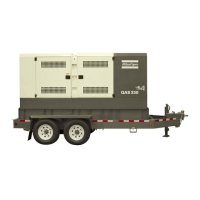- 47 -
Coolant check
Monitoring coolant condition
In order to guarantee the lifetime and quality of the
product, thus to optimise engine protection, regular
coolant-condition-analysis is advisable.
The quality of the product can be determined by three
parameters.
Visual check
– Verify the outlook of the coolant regarding colour and
make sure that no loose particles are floating around.
pH measurement
– Check the pH value of the coolant using a pH-measuring
device.
– The pH-meter can be ordered from Atlas Copco with part
number 2913 0029 00.
– Typical value for EG = 8.6.
– If the pH-level is below 7 or above 9.5, the coolant should
be replaced.
Glycol concentration measurement
– To optimise the unique engine protection features of the
PARCOOL EG the concentration of the Glycol in the
water should be always above 33 vol.%.
– Mixtures with more than 68 vol.% mix ratio in water are
not recommended, as this will lead to high engine
operating temperatures.
– A refractometer can be ordered from Atlas Copco with
part number 2913 0028 00.
Topping up of coolant
– Verify if the engine cooling system is in a good condition
(no leaks, clean,...).
– Check the condition of the coolant.
– If the condition of the coolant is outside the limits, the
complete coolant should be replaced (see section
“Replacing the coolant”).
– Always top-up with PARCOOL EG.
– Topping up the coolant with water only, changes the
concentration of additives and is therefore not allowed.
Replacing the coolant
Drain
– Completely drain the entire cooling system.
– Used coolant must be disposed or recycled in accordance
with laws and local regulations.
Flush
– Flush twice with clean water. Used coolant must be
disposed or recycled in accordance with laws and local
regulations.
– From the Atlas Copco Instruction book, determine the
amount of PARCOOL EG required and pour into the
radiator top tank.
– It should be clearly understood that the risk for
contamination is reduced in case of proper cleaning.
– In case a certain content of ‘other’ coolant remains in the
system, the coolant with the lowest properties influences
the quality of the ‘mixed’ coolant.
Fill
– To assure proper operation and the release of trapped air,
run the engine until normal engine operation temperature
is reached. Turn off the engine and allow to cool.
– Recheck coolant level and add if necessary.
Long service intervals
5-year drain interval to minimize service
costs (when used in accordance with the
instructions).
In case of a mix of different coolant
products this type of measurement might
provide incorrect values.

